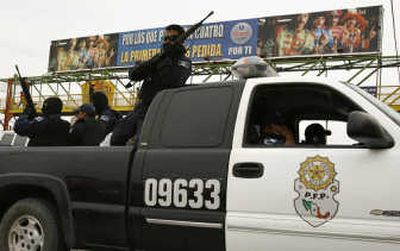Mexico’s drug war heats up

MEXICO CITY – Thousands of soldiers and federal police have mounted a new operation along the Mexico-Texas border designed to break up cells of the Zetas paramilitary drug gang, with two bloody firefights just this week, in what Mexican and U.S. officials are calling a new strategy in the drug fight.
The plan of attack for the new year goes beyond patrolling streets in border towns like Nuevo Laredo and Reynosa to actively tracking down Zeta cells in their safe houses, such as an operation Monday that left three heavily armed Zetas dead, said Patricio Patino Arias, the deputy minister for intelligence and strategy at Mexico’s Public Security Ministry.
“Since the first of January we have changed our operations,” Patino Arias told reporters. “It’s no longer just patrolling, but rather a direct fight – a direct fight against specific objects, against specific targets – that has grown out of important intelligence work.”
One U.S. law enforcement official, speaking on condition of anonymity, said the Mexican government appears to be seeking a direct confrontation with the Zetas, many of whom are former military officers or police.
“They (authorities) realize that putting out small fires isn’t going to help them very much,” said the official, who is not allowed to speak for attribution. “They’re now entering the gates of hell as they try to dismantle the organization by targeting the key figures.”
Among the targets: Heriberto Lazcano, the alleged leader of the Zetas. He is believed to be hiding somewhere in the Tampico area – the same Gulf Coast city where authorities seized 11 tons of cocaine after an October shootout between soldiers and Zetas.
“The Mexican government is being much more deliberate; the targets they’re going after are that much more sharp,” the U.S. official said. “I think they’re getting some good intelligence and that’s making all the difference.”
On Wednesday, President Felipe Calderon met with police chiefs from around the country and held a minute of silence for the hundreds of police and soldiers who have become casualties in the drug fight, including two killed in a Tuesday shootout in Reynosa.
“There have already been a lot of federal, state and municipal police, soldiers and marines who have lost their lives, especially in the last year, to guarantee the security of Mexicans,” Calderon said. “It hasn’t been easy, and there is much more to do.”
Patino Arias said the men killed and captured in Rio Bravo on Monday were part of a Zeta cell that reported to Lazcano, a former army officer.
Two men from Detroit and one from Texas were among those arrested in Monday’s shootout in Rio Bravo, Tamaulipas. The state is home base for the Gulf cartel, which uses the Zetas as its enforcement arm.
That shootout came after federal police and soldiers followed an SUV that had run a roadblock and holed up in a safe house in front of the town’s police station. Ten soldiers and police were injured by fragmentation grenades, but none seriously.
Patino Arias said the type of armament used by the Zetas, including rocket launchers used to penetrate armored vehicles, has raised violence “to a new level.”
This week’s seizure of high-powered machine guns, grenade launchers and sniper rifles shows how easy it is for organized crime to obtain weapons on the U.S. side of the border and how the drug war is becoming an increasing military-style fight, he said.
A senior U.S. official, also speaking on condition of anonymity, said government pressure on the Zetas may be forcing them to breach a reported “truce” among cartel leaders, who reportedly had agreed to lay low and reduce violence. That worked for part of the summer and fall.
The Gulf cartel has been in a fierce turf war with the Sinaloa cartel, based in the northern state with the same name.
“The reason violence is increasing boils down to increased pressure on the cartels,” the official said. “For now, the cartels may have a truce, but with pressure on them increasing, the usual response is to kick up the violence, especially against government law enforcement.”
The new year’s wave of violence comes after a year in which a record 2,500 people were killed as part of the drug fight, mostly cartel gunmen and police.
It also comes as the U.S. Congress considers $500 million in aid this year to Mexico for expensive equipment needed in the drug battle, such as helicopters and scanners.